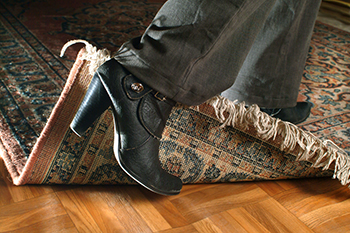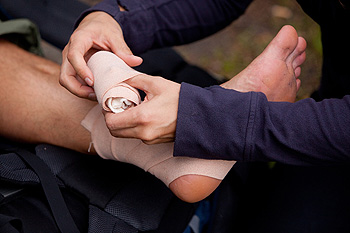Yakima
(509) 225-3668
Ellensburg
(509) 925-4633

Falling can be serious among older individuals. It can lead to debilitating injuries, many of which can affect the feet. It is helpful to discuss existing medications while having routine physical examinations and staying current with eye exams. The latter can be beneficial in updating eyeglass prescriptions. There are effective fall prevention techniques that can be put into place that may reduce the number of falls. These can include engaging in a regular exercise routine like yoga or tai chi and both can improve balance. The body can become stronger when low-impact cardiovascular exercise is frequently practiced, which may help strengthen the legs. Additionally, simple changes made in the household may significantly contribute to limiting falling episodes. These can consist of improving lighting, removing worn rugs, and installing grab bars in the shower and toilet area. If you would like more information about how falling can affect the feet, it is suggested that you consult with a podiatrist who can provide you with the correct information.
Preventing falls among the elderly is very important. If you are older and have fallen or fear that you are prone to falling, consult with one of our podiatrists from Cascade Foot & Ankle. Our doctors will assess your condition and provide you with quality advice and care.
Every 11 seconds, an elderly American is being treated in an emergency room for a fall related injury. Falls are the leading cause of head and hip injuries for those 65 and older. Due to decreases in strength, balance, senses, and lack of awareness, elderly persons are very susceptible to falling. Thankfully, there are a number of things older persons can do to prevent falls.
How to Prevent Falls
Some effective methods that older persons can do to prevent falls include:
Falling can be a traumatic and embarrassing experience for elderly persons; this can make them less willing to leave the house, and less willing to talk to someone about their fears of falling. Doing such things, however, will increase the likelihood of tripping or losing one’s balance. Knowing the causes of falling and how to prevent them is the best way to mitigate the risk of serious injury.
If you have any questions, please feel free to contact our offices located in Yakima and Ellensburg, WA . We offer the newest diagnostic and treatment technologies for all your foot care needs.

“Trampoline ankle” or a Saltar Harris fracture is a rare type of ankle fracture that happens when two or more people are bouncing out of sync on a trampoline. The resulting kinetic energy causes a high-impact effect that can a cause serious growth plate injury in a child. In this type of injury, the problem involves the growth plate, which is why it is unique to children and not adults. This type of fracture occurs when the trampoline bed is ascending and the child who sustains the injury is on the descent. The growth plate is an area of cartilage that is actively developing into new bone. The tibia bone of the leg stops growing generally around the ages of 14 to 18. If this fracture is not tended to, it can lead to permanent bone growth arrest. If your child has sustained an ankle fracture while on the trampoline, it is suggested that you visit a podiatrist as soon as possible for diagnosis and treatment.
Ankle and foot injuries are common among athletes and in many sports. They can be caused by several problems and may be potentially serious. If you are feeling pain or think you were injured in a sporting event or when exercising, consult with one of our podiatrists from Cascade Foot & Ankle. Our doctors will assess your condition and provide you with quality foot and ankle treatment.
Common Injuries
The most common injuries that occur in sporting activities include:
Symptoms
Symptoms vary depending upon the injury and in some cases, there may be no symptoms at all. However, in most cases, some form of symptom is experienced. Pain, aching, burning, bruising, tenderness, tightness or stiffness, sensation loss, difficulty moving, and swelling are the most common symptoms.
Treatment
Just as symptoms vary depending upon the injury, so do treatment options. A common treatment method is known as the RICE method. This method involves rest, applying ice, compression and elevating the afflicted foot or ankle. If the injury appears to be more serious, surgery might be required, such as arthroscopic or reconstructive surgery. Lastly, rehabilitation or therapy might be needed to gain full functionality in the afflicted area. Any discomfort experienced by an athlete must be evaluated by a licensed, reputable medical professional.
If you have any questions, please feel free to contact our offices located in Yakima and Ellensburg, WA . We offer the newest diagnostic and treatment technologies for all your foot care needs.

The majority of people that have pain in their second toe have endured an injury. It can happen if a heavy object drops on it, or from accidentally kicking something hard. Pain in this toe may cause difficulty while walking, in addition to affecting balance. The toe can become sprained, and this affects the ligament that connects two or more bones. A toe sprain can happen if the toe is twisted beyond its normal range of motion, or possibly from falling. The symptoms of a sprained second toe can include bruising, swelling, and intense pain. An X-ray can be taken to rule out a fracture, and this can be followed by beginning the correct treatment. This can consist of using the buddy taping method, which is done by taping the sprained toe to the toe next to it. This is generally successful in providing the necessary stability as it heals. If you have pain in your toes, it is suggested that you seek the counsel of a podiatrist who can guide you to the treatment that is best for you.
Toe pain can disrupt your daily activities. If you have any concerns, contact one of our podiatrists of Cascade Foot & Ankle. Our doctors can provide the care you need to keep you pain-free and on your feet.
What Causes Toe Pain?
Most severe toe pain is caused due to a sports injury, trauma from dropping something heavy on the toe, or bumping into something rigid. Other problems can develop over time for various reasons.
Toe pain can be caused by one or more ailments. The most common include:
When to See a Podiatrist
Diagnosis
In many cases the cause of toe pain is obvious, but in others, a podiatrist may want to use more advanced methods to determine the problem. These can range from simple visual inspections and sensation tests to X-rays and MRI scans. Prior medical history, family medical history, and any recent physical traumatic events will all be taken into consideration for a proper diagnosis.
Treatment
Treatments for toe pain and injuries vary and may include shoe inserts, padding, taping, medicines, injections, and in some cases, surgery. If you believe that you have broken a toe, please see a podiatrist as soon as possible.
If you have any questions please feel free to contact our offices located in Yakima and Ellensburg, WA . We offer the newest diagnostic tools and technology to treat your foot and ankle needs.

Athlete’s foot can be extremely uncomfortable. It is a foot condition that is caused by a fungal infection of the skin, and generally affects the toes and soles of the feet. The fungus that causes this condition lives in warm and moist environments, such as shower room floors and public swimming pools. Because the fungus is contagious, it is beneficial to wear appropriate shoes while in these types of areas. Additionally, it is wise to refrain from sharing shoes, towels, and socks, as this may help to limit the spread of athlete’s foot. Research has indicated there are two types of athlete’s foot fungus. Trichophyton rubrum is classified as long-lasting and may often be recurring. Trichophyton mentagrophytes is a type of fungus that is found between the toes and is treatable, despite its severity. If you have itchy skin on your feet, it is suggested that you confer with a podiatrist who can properly diagnose and treat athlete’s foot.
Athlete’s Foot
Athlete’s foot is often an uncomfortable condition to experience. Thankfully, podiatrists specialize in treating athlete’s foot and offer the best treatment options. If you have any questions about athlete’s foot, consult with one of our podiatrists from Cascade Foot & Ankle. Our doctors will assess your condition and provide you with quality treatment.
What Is Athlete’s Foot?
Tinea pedis, more commonly known as athlete’s foot, is a non-serious and common fungal infection of the foot. Athlete’s foot is contagious and can be contracted by touching someone who has it or infected surfaces. The most common places contaminated by it are public showers, locker rooms, and swimming pools. Once contracted, it grows on feet that are left inside moist, dark, and warm shoes and socks.
Prevention
The most effective ways to prevent athlete’s foot include:
Symptoms
Athlete’s foot initially occurs as a rash between the toes. However, if left undiagnosed, it can spread to the sides and bottom of the feet, toenails, and if touched by hand, the hands themselves. Symptoms include:
Diagnosis and Treatment
Diagnosis is quick and easy. Skin samples will be taken and either viewed under a microscope or sent to a lab for testing. Sometimes, a podiatrist can diagnose it based on simply looking at it. Once confirmed, treatment options include oral and topical antifungal medications.
If you have any questions, please feel free to contact our offices located in Yakima and Ellensburg, WA . We offer the newest diagnostic and treatment technologies for all your foot care needs.